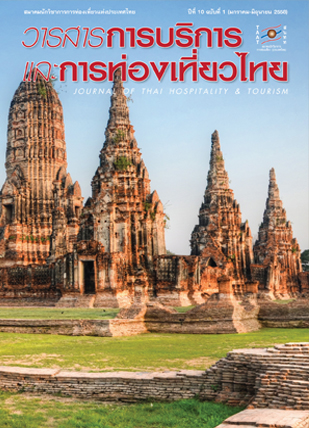The Development Guidelines for Destination Attraction and Tourism Activities of Li Jiang, The Celestial Dragon Village in Suphanburi Province
Main Article Content
Abstract
The purposes of this research were to (1) study individual characters that effect on tourists’ satisfaction at Li Jiang, the Celestial Dragon Village in Suphanburi, (2) study tourist attractions, tourist activities, the physical environment and service area that affected on tourists’ satisfaction and the tendency of tourism in the future, (3) study the relationship between the tourists’ satisfaction and behavior at Li Jiang, the Celestial Dragon Village, (4) study tourist behavior that affects on the tendency of tourism in the future at Li Jiang, the Celestial Dragon Village,5) study the tendency of tourism in the future that affects on suggestion or telling to tourists at Li Jiang, the Celestial Dragon Village in the future, (6) study the ways to develop tourist attractions, tourist activities, physical environment and services at Li Jiang, the Celestial Dragon Village in Suphanburi. Research design: Quantitative and Qualitative. The samples consisted of tourists and service staff group. The research instruments for collecting data were questionnaire and depth interview. The statistics for analyzing data were Percentage, Mean, Standard Deviation, t-test, F test, Multiple Regression Analysis, and Pearson Product Moment Correlation Coefficient. The research results were found as follows:
On Quantitative results:
Most of the tourists are female, whose age below 25, their occupations were students in the bachelor’s degree and their salaries were approximately 15,000 baht per month. Tourists ‘opinion towards tourist attractions at Li Jiang, the Celestial Dragon Village was good in total, physical environment and service area was good in total. Total satisfaction in Li Jiang, the Celestial Dragon Village was at the satisfied level. Frequency of tourists’ behavior was about 2 times per year and their expenses were 500 to 1,000 baht a time. On average, they spent 2 hours time. The tendency of tourism in the future was good.
On Qualitative results:
The results from the interview, in total there was tourist information about tourist attractions in the provincial level. There were presentations of Chinese history in tourist activities. The environment of tourist attractions was modern. The personnel always looked after tourist attractions and made them clean and beautiful.
On Quantitative results:
Most of the tourists are female, whose age below 25, their occupations were students in the bachelor’s degree and their salaries were approximately 15,000 baht per month. Tourists ‘opinion towards tourist attractions at Li Jiang, the Celestial Dragon Village was good in total, physical environment and service area was good in total. Total satisfaction in Li Jiang, the Celestial Dragon Village was at the satisfied level. Frequency of tourists’ behavior was about 2 times per year and their expenses were 500 to 1,000 baht a time. On average, they spent 2 hours time. The tendency of tourism in the future was good.
On Qualitative results:
The results from the interview, in total there was tourist information about tourist attractions in the provincial level. There were presentations of Chinese history in tourist activities. The environment of tourist attractions was modern. The personnel always looked after tourist attractions and made them clean and beautiful.
Article Details
How to Cite
Suaungkawatin, P. (2015). The Development Guidelines for Destination Attraction and Tourism Activities of Li Jiang, The Celestial Dragon Village in Suphanburi Province. Journal of Thai Hospitality and Tourism, 10(1), 59–70. retrieved from https://so04.tci-thaijo.org/index.php/tourismtaat/article/view/35508
Section
Research Article
References
[1] กัลยา วานิชย์บัญชา. (2545). การวิเคราะห์สถิติ: สถิติเพื่อการตัดสินใจ. (พิมพ์ครั้งที่ 5). กรุงเทพฯ: จุฬาลงกรณ์มหาวิทยาลัย.
[2] เทพพนม เมืองแมน และสวิง สุวรรณ. (2540). พฤติกรรมองค์กร. (พิมพ์ครั้งที่2). กรุงเทพฯ: ไทยวัฒนาพานิช.
[3] ธนียา ปัญญาแก้ว. (2541). ปัจจัยที่มีอิทธิพลต่อความพึงพอใจในงานของข้าราชการครูในจังหวัดเชียงใหม่. มหาวิทยาลัยเชียงใหม่.
[4] ธเนศ ศรีสถิตย์. (2548). การจัดการธุรกิจนําเที่ยว. เอกสารการสอนชุดวิชาการจัดการธุรกิจในแหล่งท่องเที่ยว สาขาวิชาวิทยาการจัดการ มหาวิทยาลัยสุโขทัยธรรมาธิราช.
[5] นิรันดร ทัพไชย. (2548).พฤติกรรมนักท่องเที่ยว. เอกสารการสอนชุดวิชากลยุทธ์การตลาดในอุตสาหกรรมท่องเที่ยว สาขาวิชาวิทยาการจัดการ มหาวิทยาลัยสุโขทัยธรรมาธิราช.
[6] บุญเลิศ จิตตั้งวัฒนา. (2549). การพัฒนาและการอนุรักษ์แหล่งท่องเที่ยว. กรุงเทพฯ: เพรสแอนด์ดีไซด์.
[7] ปรียาพร วงศ์อนุตรโรจน์. (2547). จิตวิทยาการบริหารงานบุคคล. (พิมพ์ครั้งที่7). กรุงเทพฯ: พิมพ์ดี.
[8] ศิริวรรณ เสรีรัตน์ และคณะ. (2541). พฤติกรรมองค์กร. กรุงเทพฯ: ธีระฟิล์มและไซเท็กซ์.
[9] กาญจนา อรุณสุขรุจี. (2546). ความพึงพอใจของสมาชิกสหกรณ์ต่อการดําเนินงานของสหกรณ์การเกษตรไชยปราการจํากัด อําเภอไชยปราการ จังหวัดเชียงใหม่. วิทยานิพนธ์วิทยาศาสตร์มหาบัณฑิต บัณฑิตวิทยาลัย มหาวิทยาลัยเชียงใหม่.
[10] กิตติมา คงอยู่. (2551). ปัจจัยที่มีอิทธิพลต่อการกําหนดจํานวนนักท่องเที่ยวชาวต่างชาติในเกาะสมุย. วิทยานิพนธ์ มหาวิทยาลัยรามคําแหง.
[11] จารุวรรณ อุชาดี. (2554). ทัศนคติและพฤติกรรมของนักท่องเที่ยวที่มาเที่ยวในจังหวัดขอนแก่น. วิทยานิพนธ์ปริญญา บริหารธุรกิจมหาบัณฑิต บัณฑิตวิทยาลัย มหาวิทยาลัยขอนแก่น.
[12] จิรานุช โสภา และคณะ. (2554). ศักยภาพการจัดการแหล่งท่องเที่ยวเมืองมรดกโลกของประเทศไทยกรณีศึกษา: อุทยานประวัติศาสตร์สุโขทัย-ศรีสัชนาลัย-กําแพงเพชรและอุทยานประวัติศาสตร์พระนครศรีอยุธยาเพื่อการท่องเที่ยวเชิงวัฒนธรรมอย่างยั่งยืน. สารนิพนธ์ศิลปะศาสตร์มหาบัณฑิต มหาวิทยาลัยราชภัฏสวนดุสิต.
[2] เทพพนม เมืองแมน และสวิง สุวรรณ. (2540). พฤติกรรมองค์กร. (พิมพ์ครั้งที่2). กรุงเทพฯ: ไทยวัฒนาพานิช.
[3] ธนียา ปัญญาแก้ว. (2541). ปัจจัยที่มีอิทธิพลต่อความพึงพอใจในงานของข้าราชการครูในจังหวัดเชียงใหม่. มหาวิทยาลัยเชียงใหม่.
[4] ธเนศ ศรีสถิตย์. (2548). การจัดการธุรกิจนําเที่ยว. เอกสารการสอนชุดวิชาการจัดการธุรกิจในแหล่งท่องเที่ยว สาขาวิชาวิทยาการจัดการ มหาวิทยาลัยสุโขทัยธรรมาธิราช.
[5] นิรันดร ทัพไชย. (2548).พฤติกรรมนักท่องเที่ยว. เอกสารการสอนชุดวิชากลยุทธ์การตลาดในอุตสาหกรรมท่องเที่ยว สาขาวิชาวิทยาการจัดการ มหาวิทยาลัยสุโขทัยธรรมาธิราช.
[6] บุญเลิศ จิตตั้งวัฒนา. (2549). การพัฒนาและการอนุรักษ์แหล่งท่องเที่ยว. กรุงเทพฯ: เพรสแอนด์ดีไซด์.
[7] ปรียาพร วงศ์อนุตรโรจน์. (2547). จิตวิทยาการบริหารงานบุคคล. (พิมพ์ครั้งที่7). กรุงเทพฯ: พิมพ์ดี.
[8] ศิริวรรณ เสรีรัตน์ และคณะ. (2541). พฤติกรรมองค์กร. กรุงเทพฯ: ธีระฟิล์มและไซเท็กซ์.
[9] กาญจนา อรุณสุขรุจี. (2546). ความพึงพอใจของสมาชิกสหกรณ์ต่อการดําเนินงานของสหกรณ์การเกษตรไชยปราการจํากัด อําเภอไชยปราการ จังหวัดเชียงใหม่. วิทยานิพนธ์วิทยาศาสตร์มหาบัณฑิต บัณฑิตวิทยาลัย มหาวิทยาลัยเชียงใหม่.
[10] กิตติมา คงอยู่. (2551). ปัจจัยที่มีอิทธิพลต่อการกําหนดจํานวนนักท่องเที่ยวชาวต่างชาติในเกาะสมุย. วิทยานิพนธ์ มหาวิทยาลัยรามคําแหง.
[11] จารุวรรณ อุชาดี. (2554). ทัศนคติและพฤติกรรมของนักท่องเที่ยวที่มาเที่ยวในจังหวัดขอนแก่น. วิทยานิพนธ์ปริญญา บริหารธุรกิจมหาบัณฑิต บัณฑิตวิทยาลัย มหาวิทยาลัยขอนแก่น.
[12] จิรานุช โสภา และคณะ. (2554). ศักยภาพการจัดการแหล่งท่องเที่ยวเมืองมรดกโลกของประเทศไทยกรณีศึกษา: อุทยานประวัติศาสตร์สุโขทัย-ศรีสัชนาลัย-กําแพงเพชรและอุทยานประวัติศาสตร์พระนครศรีอยุธยาเพื่อการท่องเที่ยวเชิงวัฒนธรรมอย่างยั่งยืน. สารนิพนธ์ศิลปะศาสตร์มหาบัณฑิต มหาวิทยาลัยราชภัฏสวนดุสิต.


